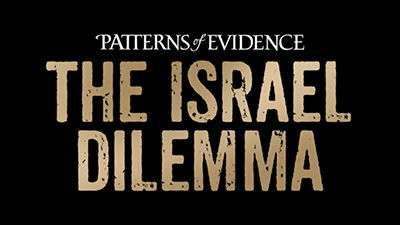Bloodline: Another Unholy Hollywood Hoax?
Once again, a movie claiming to cast doubt on the deity of Christ resorts to outright fabrications to make its case. Gordan Franz, guest columnist and archaeologist, explains.

Biblical archaeology can be an exciting subject to study and even more exciting to participate in an actual excavation of biblical significance. Hollywood was able to capture the excitement and adventure of biblical archaeology in the now-famous fictitious Indiana Jones movie, Raiders of the Lost Ark.
Sometimes Hollywood has a sinister motive when dealing with the subject of archaeology and the Bible. Recently a new archaeological movie was released that claims to cast doubts on two of the basic tenets of Christianity: the deity of the Lord Jesus and His bodily resurrection. Bloodline is produced by 1244 Films; the director and narrator of the movie is Bruce Burgess, and the producer is Rene Barnett.
The premise of the movie (that purports to be a serious documentary) is that there is “incontrovertible proof” that “totally refutes” Christianity. The movie claims that Jesus married Mary Magdalene and had a child—or children. After the crucifixion of Jesus, Mary hid the body of Jesus, and she and her child, or children, moved to France. The Knights Templar rediscovered the body of Jesus and brought his mummified body to Rennes-Le-Chateau, in southwest France in the 12th century AD.
Sound familiar? This movie claims to have the “proof” for the fictitious novel by Dan Brown, The Da Vinci Code. The film suggests that the mummified body of Mary Magdalene was recently discovered in the area of Rennes-le-Chateau along with other 1st century AD artifacts from the Jerusalem area that were associated with the wedding of Jesus and Mary Magdalene.
I attended the May 5 press conference for the movie in New York City. In the press packet was a “For Screening Only” edition of the movie. I have seen the movie several times and will base my critique on that edition.
What Is the “Incontrovertible” Evidence?
I will only summarize the “evidence” presented in the movie. For a detailed and documented refutation of the claims in this film, see my lengthy review: https://biblearchaeology.org/research/contemporary-issues/2846-bloodline-serious-documentary-or-hollywood-hoax
The “Body” of Mary Magdalene
In 1999 a British adventurer named “Ben Hammott” (not his real name) allegedly found a cave with treasures in it—as well as a burial with a shroud that had a red Knights Templar cross on it—in the hills to the east of Rennes-le-Chateau. When he returned with Bruce Burgess in 2006, “Ben Hammott” cut away part of the shroud and exposed the head and hands of a mummified person. They also took a hair sample from the body and submitted it to the Paleo-DNA Labs at Lakehead University in Canada for analysis. The mitochondrial DNA from the hair strand suggested “the Middle Eastern maternal origins of the individual based on haplotyping information.” The mummified body was on a slab of marble that suggests the individual was venerated by someone in the past. The conclusion that was drawn from this “evidence” was that this was the body of Mary Magdalene.
This mummified body (if, in fact, it is a real body) could not be that of Mary Magdalene, or any other Jewish person for that matter. During the Second Temple period (the time of Jesus), Jewish people never mummified their dead. At the burial of Jesus normal Jewish burial customs were followed (John 19:38–40), and one would assume the same thing would have occurred with Mary Magdalene’s burial. Jewish burial entailed letting the flesh decay and after a year, the family gathered up the bones and placed them in bone boxes called ossuaries. This practice was called ossilegium, or secondary burials.
The Artifacts from Jesus and Mary Magdalene’s Wedding
The second discovery was a wooden chest that contained a small bowl or cup, an ungenterium, a glass phial with a parchment inside and about 30 coins. These 1st century AD artifacts, probably originating from the area of Jerusalem, were claimed to be from the wedding of Jesus and Mary Magdalene!
Before we review these objects, we should address the issue as to whether Jesus and Mary Magdalene were married. This is the premise of The Da Vinci Code, but there is no biblical evidence—or other first-century AD evidence—for this idea, so it should be dismissed.
“Ben Hammott” allegedly discerned “clues” in the statues and pictures on the wall of the Mary Magdalene church in Rennes-le-Chateau that led him and the producer on an archaeological scavenger hunt for bottles that provided further clues that led them to the wooden chest.
In the third bottle there was a parchment that allegedly contained the confession of the priest that reburied the “body” of Mary Magdalene in the Knights Templar tomb. It said: “The resurrection of Jesus was a trick, it was Mary Magdalene who took his body from his tomb. The disciples were fooled. Later, the body of Jesus was discovered by the Templars and then hidden three times. The Knights protected a great secret which I have found. Not in Jerusalem. The Tomb is here. Parts of the body are safe. Rome knows all about this, but they cannot afford to let the secret be known. They threatened to kill if the location of the tomb was revealed.”
This is the over-riding message that Bloodline is trying to convey. Jesus did not come back from the dead, thus He is not God. This statement goes contrary to what Dr. Luke writes about in the beginning of the book of Acts. “To whom [the apostles] He [the Lord Jesus] also presented Himself alive after His suffering by many infallible proofs, being seen by them during forty days and speaking of the things pertaining to the Kingdom of God” (Luke 1:3). (See also Entropy and the Resurrection.)
As an archaeologist, my imagination was taxed as I watched the movie’s scavenger hunt. Even the messages found rolled up in the bottles looked like they were written with red felt-tipped pens! Once they found the cave that had the chest in it, they used a dowsing rod to locate the exact spot of the chest. After digging a few centimeters, voilà, there was the wooden chest! (If only real archaeology could be this easy.)
In the press release, it was stated that the chest was “extremely damp and rotten.” When I looked at it during the New York news conference, it did not look rotten (although I did not handle it). In the movie, when Hammott was using the petech (a tool used by archaeologists for digging dirt), he hit the wood of the chest. It gave a sound of a solid piece of wood from a box that was hollow inside and did not give the sound of wood that was “damp and rotten.” If the wood was “damp and rotten,” it would have crumbled, or at least left a hole in the top of the chest made by the petech.
The first artifact in the chest was described in the press release as a “simple pottery drinking cup.” The pottery expert who examined it, Professor Gabriel Barkay from Bar Ilan University in Israel, said it could also be a small bowl and stressed that it was a “common” artifact in everyday use by everybody.
Jewish weddings during the Second Temple periods were elaborate and festive affairs. The bride and groom would not have used a common cup made of coarse pottery for their wedding festivities, but rather, one of silver, gold, glass, or Eastern terra sigillata pottery. Using a “common” cup, if it was a cup and not a bowl, would be like a wealthy bride and groom at a wedding today toasting each other with a Styrofoam cup!
The second artifact in the box was identified as an ungenterium. In the 1st century AD it was called a piriform bottle. This object is used to hold unguents, or perfumes, and is used for domestic as well as funerary purposes. They were regularly left in tombs so that the perfumes could counteract the smell of the decomposing flesh.
This piriform bottle could not have been the object used by “Mary of Bethany, alias Mary Magdalene” (according to the movie) to anoint Jesus for His burial for three reasons. First, the piriform bottle is made of clay, but the Bible says that the vessel Mary of Bethany anointed Jesus with was made of alabaster (Matthew 26:7; Mark 14:3). Second, the piriform bottle is completely intact. The Bible says Mary broke it in order to anoint Jesus (Mark 14:3). Finally, the vessel is too small. The Bible says it contained a pound of spikenard, thus the vessel would have been much larger then the one found in the chest (John 12:3).
Professor Barkay was asked how these objects could have made their way to a cave in France. He suggested two possibilities. First, the Knights Templar brought them back to France with them in the 12th century. The second possibility is that they were purchased on the antiquities market in Israel and taken to Europe recently. I am inclined to believe the latter makes more sense.
I suspect, but cannot conclusively prove at this point, that this is all a Hollywood hoax. The “mummified body” apparently is made of plastic; the artifacts were probably recently bought on the antiquities market in Jerusalem and placed in a wooden chest that was buried in a cave near Rennes-le-Chateau; and the elaborate archaeological scavenger hunt was probably concocted by the Hollywood types for suspense and adventure in the movie. Bottom line: this movie should not be taken seriously and comes nowhere close to the exciting adventures of the fictitious Indiana Jones. Skip this flick.
The Agenda of Bloodline
At the end of the movie, Bruce Burgess said, “For the record, I do think that it’s possible that these discoveries, especially the chest and maybe even the tomb were somehow placed there for Ben, and us to find. That doesn’t make them fake in any way. It just means that someone with an agenda wanted this material revealed, but who?”
I can think of three possibilities. First, some secret organization (in the movie it is the fictitious Priory of Sion) wants to disprove the deity and bodily resurrection of Jesus and will bump off anybody in the way of their agenda. Second, people want to sell books and movie tickets. There is a third, yet more driving, possibility. Bloodline has an agenda. The message they are trying to get out, disguised as a serious documentary, is that Jesus is not God manifest in human flesh and He did not come back from the dead.
The Conclusion of the Matter
The poster for the movie asks the provocative question: “What if the greatest story ever told was a lie?” I think the wrong question was asked. It should have been, “What if the premise and storyline of Bloodline is a lie?” The historical, biblical, and archaeological evidence suggests that this is the case.
The greatest story ever told is still true. The Lord Jesus, in love, left the glories of heaven, humbled Himself, veiled His glory and became a man in order to die on a cross outside of Jerusalem in order to pay for all the sins of humanity (John 3:16; Romans 5:8; Philippians 2:5–11; I John 2:2). Three days later, He was bodily resurrected from the dead and is now seated at the right hand of the Father. He left no physical bloodline because He never married Mary Magdalene; He lived a perfect, sinless life here on earth as God manifest in human flesh. However, He does have a spiritual bloodline that is composed of all who have put their trust in Him and Him alone for their salvation (Hebrews 2:10). His spiritual children did not earn their salvation; they did not work for it; they did not join a church or get baptized; they simply trusted Jesus to forgive all their sins so He could give them His righteousness so they could enter a perfect Heaven and be in the presence of a holy God forever (Acts 13:38–39, 16:30–31; Romans 4:5; Philippians 3:9; Titus 3:4–7; 1 John 5:13).
Do not believe the lie of the movie Bloodline, but rather, believe the truth of the Word of God, the Bible. Your eternal destiny, Heaven or Hell, will be determined by what you believe.
For more information:
is a Bible teacher who holds an MA in Biblical Studies from Columbia Biblical Seminary, SC. For almost 29 years, he has engaged in extensive research in archaeology and has participated in a number of excavations in and around Jerusalem, including Ketef Hinnom and Ramat Rachel, as well as the excavations at Tel Lachish, Tel Jezreel and Tel Hazor. He has taught the geography of the Bible and led field trips in Israel for the Jerusalem Center for Biblical Studies, the Institute of Holy Land Studies, and the IBEX program of Master’s College. He also co-teaches the Talbot School of Theology’s Bible Lands Program. Gordon is on the staff of the Associates for Biblical Research (http://www.biblearchaeology.org/).

Answers in Genesis is an apologetics ministry, dedicated to helping Christians defend their faith and proclaim the good news of Jesus Christ.
- Customer Service 800.778.3390
- Available Monday–Friday | 9 AM–5 PM ET
- © 2025 Answers in Genesis




